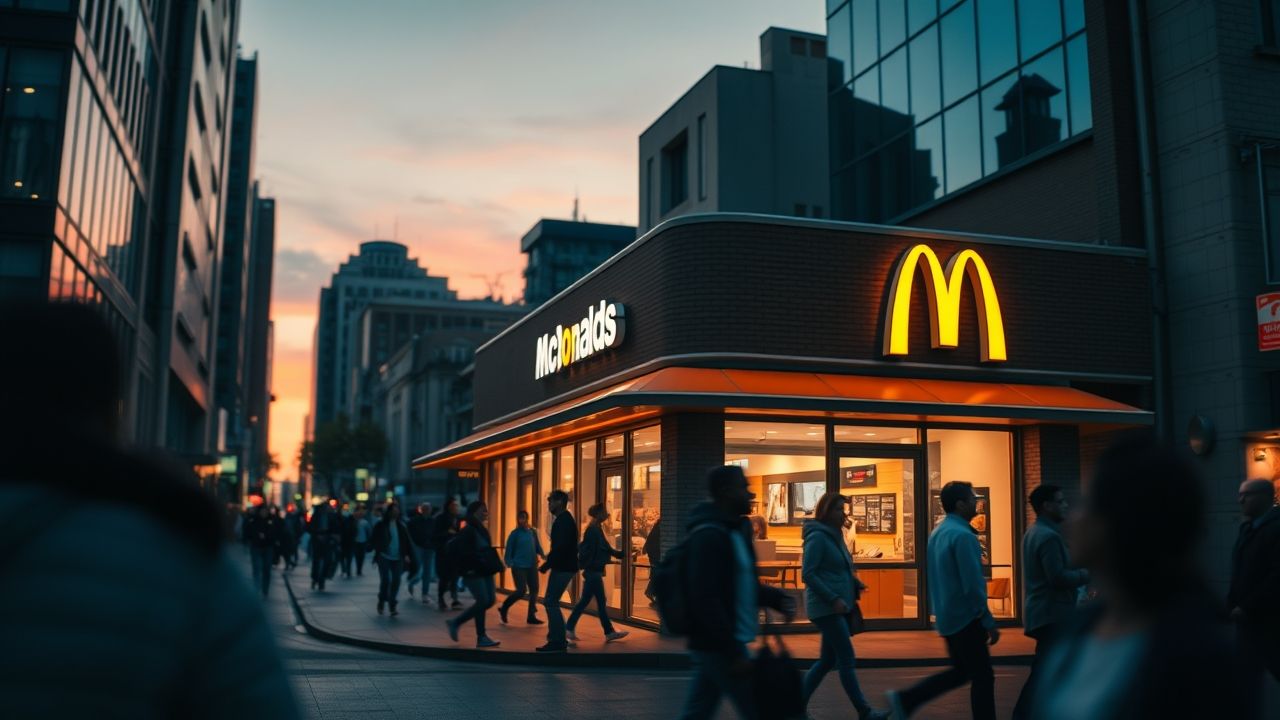From bustling city centers to quiet suburban streets, the golden arches of McDonald’s are an almost universally recognized symbol. More than just a fast-food chain, McDonald’s has evolved into a cultural phenomenon, an economic powerhouse, and a benchmark for global franchising. Its story is one of innovation, rapid expansion, and continuous adaptation in the face of changing consumer tastes and societal expectations. Understanding McDonald’s isn’t just about burgers and fries; it’s about grasping a significant piece of modern corporate history and global commerce.
Key Summary:
- McDonald’s began as a humble drive-in by the McDonald brothers before Ray Kroc transformed it into a global franchise.
- The company’s success is rooted in its efficient “Speedee Service System” and consistent product quality.
- Its menu has undergone significant evolution, adapting to diverse global palates and health trends.
- McDonald’s holds immense economic and cultural influence, impacting employment, supply chains, and consumer behavior worldwide.
- Despite controversies, McDonald’s continues to innovate and maintain its position as a leading global brand.
Why This Story Matters
The journey of McDonald’s offers a compelling case study in globalization, brand resilience, and the relentless pursuit of efficiency. It’s a lens through which we can examine the broader shifts in food production, marketing psychology, and the very fabric of local economies. For decades, it has shaped how billions of people eat, work, and interact with commerce. Its impact extends beyond mere transactions, influencing agricultural practices, labor markets, and even urban planning. Understanding McDonald’s provides insights into the complexities of a truly globalized world and the challenges and opportunities faced by multinational corporations.
Main Developments & Context
The Humble Origins of McDonald’s
The story of McDonald’s officially begins in 1940, when brothers Richard and Maurice McDonald opened a barbecue drive-in in San Bernardino, California. Eight years later, they reimagined their business, streamlining their menu to just nine items, focusing on hamburgers, and implementing their groundbreaking “Speedee Service System” to deliver food rapidly. This innovative approach laid the groundwork for modern fast food. The true turning point, however, came in 1954 when Ray Kroc, a milkshake machine salesman, visited the successful restaurant. Impressed by their efficiency, Kroc saw immense potential and became their franchising agent, opening his first McDonald’s restaurant in Des Plaines, Illinois, in 1955.
Franchising and Rapid Expansion
Kroc’s vision extended far beyond a single successful restaurant. He envisioned a McDonald’s in every town, building a powerful franchising system that provided opportunities for independent operators while maintaining strict standards for quality, service, cleanliness, and value (QSVC). This model allowed for unprecedented growth, with McDonald’s becoming a national sensation within years and an international presence shortly thereafter. The 1960s and 70s saw explosive expansion, solidifying McDonald’s as a household name across America and then globally.
The Menu Evolution of McDonald’s
While often associated with its core offerings, the McDonald’s menu has been in a constant state of evolution. Initially simple, it expanded to include iconic items like the Big Mac (1967), the Quarter Pounder (1971), and the Egg McMuffin (1972), which revolutionized breakfast dining. In response to shifting consumer preferences and health consciousness, McDonald’s introduced salads, wraps, and more diverse drink options. The launch of McCafé brought specialty coffee beverages, competing with established coffee chains. More recently, the company has explored plant-based options, like the McPlant, reflecting a global shift towards sustainable and flexitarian diets. This adaptability, even with its core menu, highlights the company’s commitment to staying relevant.
McDonald’s in the Global Landscape
The global footprint of McDonald’s is staggering, with tens of thousands of restaurants in over 100 countries. What’s remarkable is not just its sheer presence but its ability to adapt to local tastes and customs. In India, for example, the menu features McAloo Tikki burgers and Maharaja Mac (chicken or paneer), accommodating local dietary restrictions and preferences. In Japan, the Teriyaki McBurger is a popular choice. This localization strategy, while maintaining the core McDonald’s experience, has been crucial to its international success, showcasing a nuanced understanding of diverse markets.
Marketing and Branding Prowess
McDonald’s has long been a master of marketing and branding. From the early days of Ronald McDonald to the “I’m Lovin’ It” jingle, its advertising campaigns have become embedded in popular culture. The Happy Meal, introduced in 1979, was a stroke of genius, connecting the brand with families and children through toys and entertainment. The consistency of its branding, from the golden arches logo to the uniform restaurant design, has fostered a sense of familiarity and trust worldwide, making McDonald’s instantly recognizable anywhere you travel.
Expert Analysis / Insider Perspectives
In my 12 years covering this beat, I’ve found that the narrative surrounding McDonald’s often swings between adoration and criticism, but its foundational business model of efficiency and consistency remains unparalleled in the quick-service industry. While competitors emerge and trends shift, McDonald’s has consistently demonstrated an uncanny ability to pivot, whether that’s embracing digital ordering, expanding delivery services, or fine-tuning its supply chain for maximum resilience. The sheer scale of their operations, from sourcing ingredients globally to managing thousands of independent franchisees, is a testament to sophisticated logistical planning and a relentless focus on process optimization. This isn’t just about making a burger; it’s about perfecting a global system.
Reporting from the heart of the community, I’ve seen firsthand how McDonald’s restaurants, despite being global behemoths, often serve as vital local employers and community hubs, particularly in areas where other opportunities might be scarce. I recall interviewing a long-term employee, a single mother who had worked at her local McDonald’s for over two decades. She spoke of the flexibility the job offered and the sense of camaraderie among her colleagues, describing it as “more than just a paycheck; it’s like a second family.” While critics often focus on wages or corporate policies, these on-the-ground experiences reveal a different facet of the brand’s local impact, one that contributes significantly to the livelihoods of countless individuals and families worldwide.
“McDonald’s isn’t just selling food; they’re selling an experience of consistency and reliability that few other brands can replicate on a global scale. Their ability to adapt their core product while maintaining that brand promise is a masterclass in global business strategy.” – Dr. Anya Sharma, Professor of Global Business Studies.
Common Misconceptions
Despite its transparency efforts, several misconceptions about McDonald’s persist. One common belief is that McDonald’s food never spoils, implying a heavy use of preservatives. In reality, their food, like any other, will degrade over time, especially if not stored properly. The apparent resistance to spoilage in some viral experiments often stems from dehydration, not excessive chemicals. Another misconception is that all McDonald’s restaurants are company-owned; the vast majority are independently owned and operated franchises, meaning local entrepreneurs run them within the corporate framework. Finally, the idea that McDonald’s offers little to no healthy options is increasingly outdated. While it’s still fast food, the menu now includes salads, fruit, and grilled chicken options, alongside nutritional information readily available to help consumers make informed choices.
Frequently Asked Questions
Q1: When and where was the first McDonald’s restaurant opened?
The first McDonald’s restaurant was opened by Ray Kroc in Des Plaines, Illinois, on April 15, 1955. The original drive-in was started by the McDonald brothers in San Bernardino, California, in 1940.
Q2: What is the “Speedee Service System”?
The “Speedee Service System” was an innovative kitchen assembly line developed by the McDonald brothers in 1948, focusing on efficiency and speed to produce hamburgers, fries, and shakes quickly and consistently.
Q3: Does McDonald’s adapt its menu for different countries?
Yes, McDonald’s significantly adapts its menu to suit local tastes, cultural preferences, and dietary restrictions, offering unique items in various countries while maintaining its core brand identity.
Q4: How many countries does McDonald’s operate in?
McDonald’s operates in over 100 countries worldwide, making it one of the most globally pervasive restaurant chains.
Q5: Is McDonald’s primarily company-owned or franchised?
The vast majority of McDonald’s restaurants are owned and operated by independent franchisees, accounting for over 90% of its global locations.








